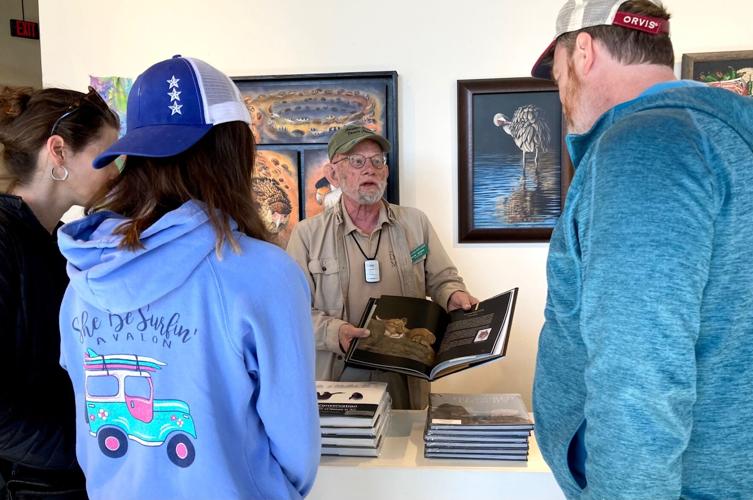More than 400,000 people will visit the Arizona-Sonora Desert Museum this year. Chances are they will leave with 400,000 different memories to share with their friends back home, but describing just what the museum is may not be so easy.
Is the Desert Museum a zoo? An aquarium? An arboretum? An art gallery? A science center?
The answer is “yes,” it is all those things, which is why the recently published “Treasured Legacies” is such an ambitious — and noteworthy — addition to the library of Tucson literature.
Released in September by Arizona-Sonora Desert Museum Press, “Treasured Legacies” was selected as one of the Southwest’s Books of the Year by the Pima County Public Library.
It is as hard to summarize as the museum itself; more than an artist’s portfolio, more than an album of photos, more than a written history.
It is all those things, all in 77 pages that would work just as well in your bookcase as on the coffee table.
“Every time you go to the museum you notice things you hadn’t seen before,” said co-collaborator Anne Warner. “After you’ve seen the animals, you notice the artwork. You see the sculptures and read the poetry. You hear what the docents are teaching the kids while they’re letting them touch a snake. The museum is lots of things. We wanted the book to be lots of things, too.”
Warner, a museum volunteer since 2011, was the editor. Other collaborators include Priscilla Baldwin, who co-founded the ASDM Art Institute; Peggy Larson, the ASDM librarian and archivist; and Craig Ivanyi, its executive director.
Their interests and influences are woven together throughout the book, most visibly by the scratchboard portraits of desert animals by Baldwin.
“The book is driven by her art,” Warner said. “Since the museum’s earliest days, (co-founder) Bill Carr wanted a natural history art museum to be an important part of what we do. He believed art helped tell our story. It always has.”
“Treasured Legacies” is a natural complement to another Desert Museum publication, “A Scrapbook,” written by Larson and first published by the museum in 2001. It used photos and short stories to lead readers through the museum’s history.
“Treasured Legacies” invites readers to look closely at Baldwin’s scratchboards, which in turn magnify the beauty of animals.
Some Tucsonans, one of us for sure, are surprised to learn the ASDM Art Institute is such an important component of the museum’s educational program. The institute offers classes, workshops and special exhibitions. A state-of-the-art gallery of wildlife and nature paintings is open daily on museum grounds.
Don’t despair, history guy. “Treasured Legacies” reveals that Carr arrived in Tucson in 1944 with $400 in his pocket, most of which he used to open a bookshop near the university. You’ll be reminded the Desert Museum helped establish wildlife sanctuaries near the Gulf of Mexico and reestablish the presence of the Mexican gray wolf in Southern Arizona.
We hear the story behind the museum’s longtime mascot, George L. Mountainlion, and smile when reminded about the “Desert Ark” – the Studebaker station wagon Hal Gras drove when taking desert animals to visits at area grade schools.
Words, photos and paintings all contribute to the museum’s mission, which is to help us understand and appreciate the natural wonders of the Sonoran Desert.
“Bill Carr said the Desert Museum is dedicated to life, pure and simple,” Warner noted, pointing to Chapter 4. “Living it, conserving it, preserving it. …. The book reminded us how far the museum has come. But it also made us wonder what the museum will look like 50 years from now; not just our museum, but all museums. All zoos and aquariums, too. What will we look like? What role will we all play?”
It is comforting to know the Arizona-Sonora Desert Museum is already thinking about these things. Thanks to books such as “Treasured Legacies,” we can begin thinking about them, too.
“Treasured Legacies” is available at the Arizona-Sonora Desert Museum gift shop and the ASDM Art Institute. Both take book orders over the phone. Call 520-883-3008 or 520-883-3024.
FOOTNOTES
The Pima Library Foundation will feature “Treasured Legacies” and chat with its four collaborators in its next “Salon Series” webinar Thursday at 4 p.m. They will discuss their newly published book and other Desert Museum initiatives. The online conversation is free and open to the public. To register, visit thepimalibraryfoundation.org/ salons
The Desert Museum opened on Labor Day, 1952, with freshly-cut dirt trails through the desert behind the Tucson Mountain House, which was built by the Civilian Conservation Corps and still serves as museum offices. The road through Gates Pass was dirt. Tucson had a population of around 40,000. Museum regulars might be well-advised to purchase “A Scrapbook,” which is available in the ASDM gift shop. It recounts those early days in words and pictures.
An estimated 100,000 people assembled for the Tucson Festival of Book two weeks ago, executive Melanie Morgan said. It was Tucson’s first in-person festival in three years. Morgan said she was “happy,” “grateful” and “thrilled” that so many authors, volunteers and patrons joined the coming-back party at the University of Arizona.




